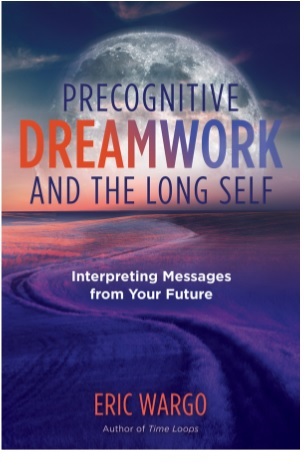

Precognitive Dreamwork and the Long Self:
Interpreting Messages from Your Future
By
Eric Wargo
A Brief Review by Henry Reed
Most every night your dreams are being influenced by experiences you will have in the future. An Experiment in Time, by J.W. Dunne, published in 1927 proved as much and is perhaps the most referenced of all books about dreams. Dunne created the paradigm for studying time in dreams: He kept a detailed daily diary as well as a daily dream diary. Once a year or so, he would go through both diaries carefully to look for connections. He found that his dreams were populated equally by experiences from the past and from the future.
In a small replica of his experiment, I perused my own past diaries for several years running, and found similar evidence. What was surprising to me was that many times, I saw that I was using a future experience to provide the imagery to discuss a current situation. I realized from that brief experiment that a person normally would never suspect they were borrowing from the future to express their dreaming revelations, or that they were participating in across time coordinations.
It can be a real eye-opener to attempt Dunne’s experiment. A good case in point is a new book out on dreams that turns psychical research (ESP) on its head. Precognitive Dreamwork and the Long Self: Interpreting Messages from Your Future, by Eric Wargo is the result of not only his own dream experiences, but also from extensive communication and collaboration with others. We are in a different generation than Freud or Dunne, and the end of the materialistic paradigm shapes how we see things. For this modern author and his colleagues, he adopts from the get-go Einstein’s own proposition that physical reality is an illusion, that consciousness is the ultimate reality, and that “anything” that seems to “exist” in the resulting energy vibrations universe, actually exists in relationship to “something else.” Clearly I’m not doing a good job of explaining the basic ideas here, but found myself overwhelmed with exciting inspirations as I contemplated the vision he presented, letting go of older metaphors in favor of the new paradigm.
One fascinating idea to contemplate is that we do not dream about the future itself, but we dream about our future experience of it. A clear future orientation in the dreams, but a subjective one… yet, isn’t the reality of things that it is how we experience it that is the reality for us?
To give one very specific, concrete example of how the author is turning things inside out, is how he treats the famous story from Jung’s autobiography on how he came to develop the synchronicity principle. In his story, just as the patient is describing her dream about a bird pecking at the window, a real bird appears at the window and begins pecking. Jung calls this a “synchronistic” event. Wargo interprets the event as an example of precognitive dreaming. The difference makes a lot of difference in terms of parapsychology and ESP theory, as well as in dreamwork.
Dreamwork is really the focus of the author’s sharing here. He has found ways to incorporate this perspective on future dreaming into both a path of personal growth, but also as a way to navigate through the questions life out there presents for us. If you have the patience that dreamwork provides, and you have curiosity about where our imagination is taking us into the future, then you’ll find Wargo’s vision, and his exercises and experiments, quite relevant and to your liking.
Just think: right now you are subliminally (unconsciously) aware of all your future experiences. Do you suppose that your future you might be calling out to you now, hoping for some coordination? Wargo’s book has methods you can use to engage the collaboration. More than that, his imagery may enable you to envision all of creation, past, present and future, and everyone’s and everything’s experience as one huge symphony. We are constantly choosing, according to our dreams, which vibrational patterns we wish to explore. Try out some of Wargo’s exercises and you’ll get a feeling for what I’m suggesting.